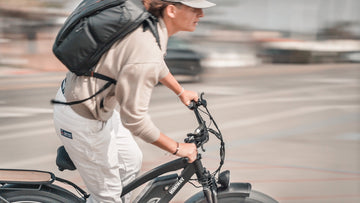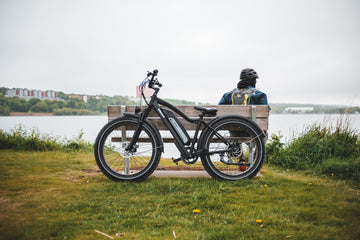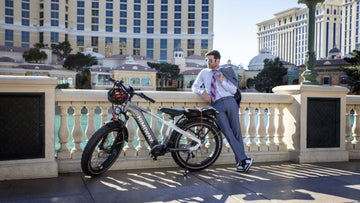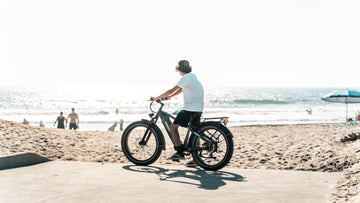Welcome to the world of e-bike enthusiasts! Today we embark on a journey to explore the aspect of e-bike tire pressure and its significant impact, on your overall biking experience.
Understanding tire pressure isn't for the gearheads; it's the ingredient that can make your rides smoother, faster and more enjoyable.
Imagine this; effortlessly gliding through terrains conquering trails with ease on your fat electric bike. What makes this exhilarating adventure possible?
It's all thanks to tire pressure—the hero. In this guide, we'll uncover the importance of maintaining tire pressure, unlocking the potential of your fat e bike for an unmatched ride.

What You Should Understand About Fat E-Bike Tires
Let’s begin by examining the structure of e-bike tires. Unlike their sleeker counterparts, fat e-bike tires have a size.
These robust companions are specifically engineered to function with tire pressure, which is a crucial characteristic that sets them apart. Think of them as, off-road warriors ready to conquer any surface with their construction and distinct attributes.
Now, why should you opt for fat tires? It's not just about their dimensions; it's about the advantages they bring to your biking experience. These oversized wheels offer improved traction and stability, transforming the challenging terrains into your personal playground.
Whether you're traversing shores, snowy landscapes or muddy trails, fat tires provide a grip that gives you the confidence to explore the great outdoors without limitations.
Enter the world of Himiway. A pioneer in manufacturing top-notch fat tire e bikes. Their product lineup exemplifies innovation and caters to riders who seek adventure across landscapes.
Himiway fat tire e bikes are designed for versatility. Guarantee a riding experience regardless of conditions. Whether it be rugged mountains or sandy beaches.
It's more than a bike; it's a companion crafted specifically for the adventurous cyclist, within you. Prepare yourself for an adventure, into the wild with the assistance of Himiways state-of-the-art technology, for tire bikes.
What Are The Roles Of Tire Pressure?
Tire pressure goes beyond being a number; it acts as a conductor, harmonizing performance and comfort. Understanding this balance is the key, to unlocking the potential of your ride.
Imagine this situation; tires that are underinflated. It feels like trying to ride through molasses. The handling becomes sluggish, rolling resistance increases and efficiency is compromised.
On the other hand, having overinflated tires can result in a ride and reduce the tire's contact with the road, affecting traction. It's like a dance where finding the perfect balance is crucial for handling, efficiency and most importantly, comfort.
The real magic lies in achieving that balance. Discovering the spot for tire pressure is similar to finding that position on your bike where performance and comfort seamlessly come together. Experimentation becomes your ally here; pay attention to how the ride feels.

How To Determine The Correct Tire Pressure
Take into consideration factors like your weight, the terrain you'll be riding on and the width of your tires as your guiding principles. Lighter riders may benefit from pressure, which can provide a smoother ride. Heavier riders might find it beneficial to have pressure for better support.
When it comes to Himiway fat tire e-bikes specifically, there is a recommended range of 20 to 30 PSI for tire pressure. This range has been carefully calibrated to ensure performance and comfort. It's not just a number; it's like a prescription for an exceptional riding experience.
By staying within this recommended range, you'll ensure that your Himiway e bike appreciates every turn of its wheels.
Adaptability is key in the world of cycling. Imagine transitioning from a road to a challenging mountain trail – your tire pressure should adapt accordingly.
Adjusting the tire pressure based on changing conditions is what keeps your ride at its best.
Steps To Check And Adjust Your Tire Pressure
1. Get a tire pressure gauge. You can choose between analog gauges.
2. Refer to your bike's manual or the manufacturer's guidelines to find the recommended tire pressure range. For example, if you have a Himiway fat tire electric bike, the ideal range might be 20–30 PSI.
3. Remove the valve cap from one tire. Attach the gauge to the valve stem. You'll hear air entering the gauge. See a reading.
4. If the reading is below the recommended range, use a pump to add air until you reach the desired pressure. If its above the range, release some air gently until you reach the target PSI.
5. Repeat this process for each tire individually to ensure consistency and optimal performance.
6. Once you have achieved the pressure, for all tires, securely put back on the valve caps.
7. The little caps may appear insignificant. They play a role, in preventing dirt and debris from reaching your valves.
8. Verify Before Setting Off. Before you embark on your journey, take a moment to inspect your tires one time. Make sure they are all at the recommended pressure level. It only takes a second. The benefits, in terms of performance and comfort, are definitely worth it.
How You Can Adjust Tire Pressure with a Pump or Compressor
1. Choose the Appropriate Pump
Select a pump that's suitable, for your fat e bike tires. Most modern pumps come with nozzles, ensuring they can fit types of valves.
2. Connect the Nozzle
Remove the valve cap from your tire and securely attach the pumps nozzle to the stem. Make sure it fits snugly to avoid any air leakage.
3. Keep an Eye on the Pressure Gauge
If your pump has a pressure gauge built in to monitor it while you're pumping air into the tire. If not, use a pressure gauge intermittently to check and maintain the desired pressure.
4. Start Pumping
Begin pumping air into the tire, maintaining a steady pace. Pause from time to time to check the pressure levels and adjust accordingly based on your recommended range.
5. Regularly Monitor Pressure
While pumping, periodically check the pressure gauge to prevent overinflation. This step is crucial in achieving a balance for your ride.
6. Release Excess Air
In case of overinflation don't worry! Simply press down on the pump nozzle, against the valve stem to release amounts of air until you reach your target pressure.
7. Secure the Valve Cap
Once you've achieved your desired tire pressure, ensure you securely place back and tighten the valve cap onto the stem. This simple action assists, in keeping things clean and stops dust and dirt from getting into the valve.
Advantages of Investing in a Quality Tire Pressure Gauge and Pump
Investing in a top-notch tire pressure gauge and pump is, like treating your chunky e bike with care. Here's why:
1. Accuracy Matters
A high quality pressure gauge provides readings enabling you to set the pressure for your bike. Getting the measurements right is crucial for achieving performance.
2. Boost in Efficiency
A pump guarantees inflation. Whether you're starting from scratch or making adjustments, a quality pump gets the job done swiftly ensuring you can hit the road again in no time.
3. Long Term Cost Savings
While quality gauges and pumps may seem like an investment, they actually save you money in the haul by preventing premature tire wear and potential damage caused by incorrect pressure.
4. Convenience on the go
Compact and portable pumps become a cyclists' companion. Having one, with you during rides, ensures that you can make adjustments while adapting to terrains or changing weather conditions.
Tips for Storing E Bikes with Tires
When you're ready to put your e-bike, it's important to think about how you store it. Lift the bike off the ground to alleviate pressure on the tires.
If possible, find a dry place for storage. Remember, giving your bike some tender loving care during storage will go a way in preventing pressure loss and keeping your tires in great shape for when you want to ride again.
The Role of Temperature Changes and Precautions
Temperature plays a significant role, in tire pressure. As the temperature rises or falls, so can your tire pressure. In weather, tire pressure tends to decrease.
On the other hand, during weather it can increase. Be mindful of these changes. Make adjustments accordingly.
Before setting off on a ride after experiencing temperature shifts, take a moment to check and adjust your tire pressure. It's a step that ensures your e bike is prepared for any weather conditions that come its way.
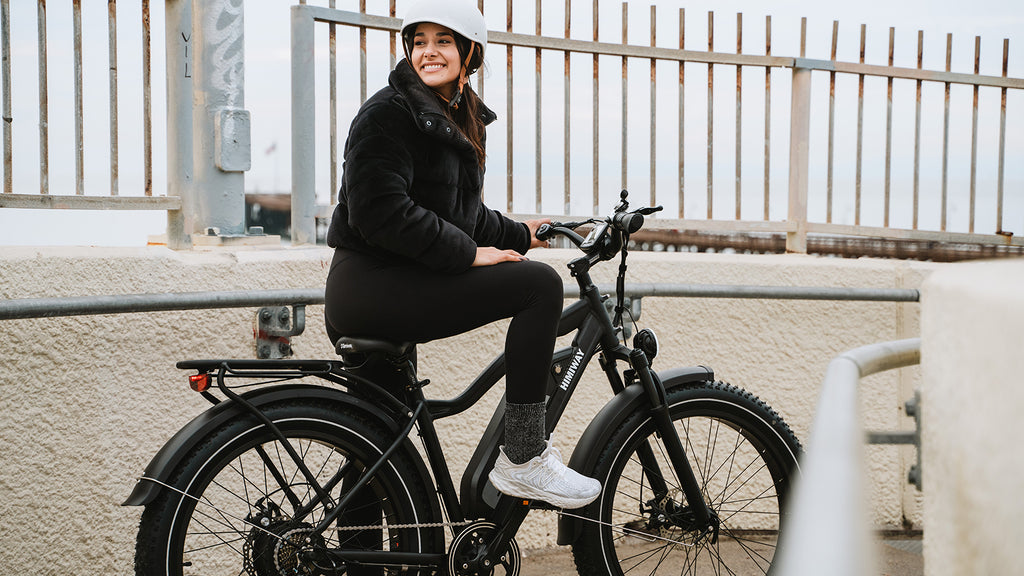
Conclusion
We appreciate your exploration of tire pressure for your electric fat bike. It shows your commitment to maintaining conditions, which speaks volumes about your love for cycling. Embrace the thrill of adventure and discover horizons. Relish the freedom that comes with a well-tuned electric fat bike.
Before you embark on your journey, take a moment to reflect on the significance of tire pressure as a link between you, your bike, and the magnificent outdoors. May every ride be filled with discoveries and the gratification of a tuned experience.
Share your experiences and tips with cyclists to contribute to our knowledge. Thank you for being part of the intersection where technology meets adventure. Here's to countless exhilarating rides on your electric fat bike. Happy cycling!














